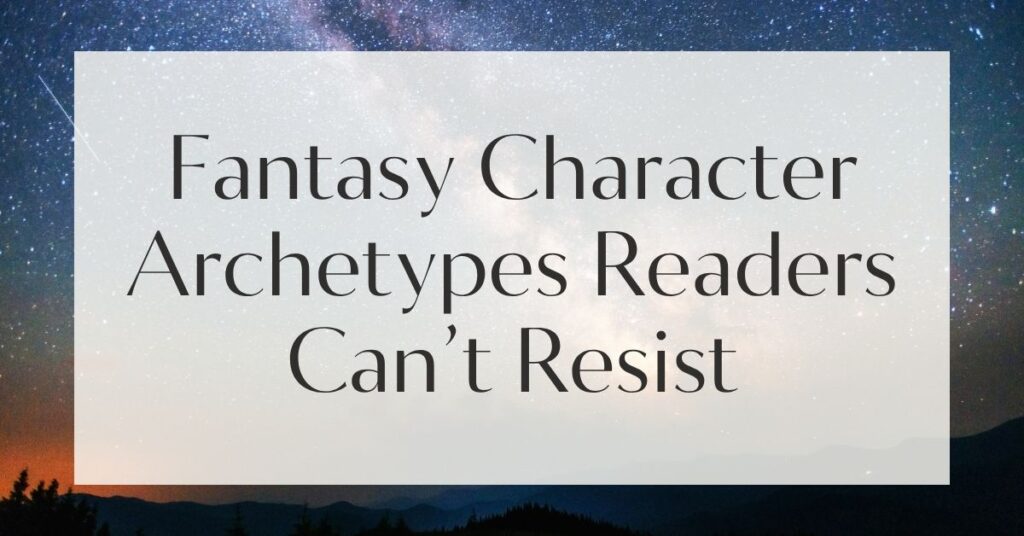In the vast realms of fantasy literature, where dragons soar and wizards weave spells, there lies a treasure trove of characters that capture our imaginations and linger in our hearts.
Have you ever wondered why certain characters resonate so deeply, drawing us into their stories and making us cheer for their triumphs or gasp at their betrayals?
These characters often fall into fantasy character archetypes—timeless patterns that echo throughout the ages, each bringing its own magic to the narrative tapestry.
Exploring Fantasy Character Archetypes
The allure of fantasy character archetypes lies in their ability to tap into universal themes and emotions, offering a familiar yet fresh lens through which we view their fantastical worlds.
They are the backbone of many beloved tales, providing structure and depth to the stories that captivate us.
Understanding the Appeal of Fantasy Character Archetypes
Fantasy character archetypes appeal to readers because they embody core human experiences and emotions. From the courageous hero to the mischievous trickster, these archetypes allow us to explore the spectrum of human nature in a safe and imaginative setting.
The hero’s journey, a common motif in fantasy, resonates with our desires for growth and transformation. Whether it’s Frodo Baggins braving the perils of Middle-earth or Harry Potter confronting his destiny, these characters invite us to embark on epic adventures, reflecting our own struggles and aspirations.
The Role of Archetypes in Reader Engagement
Archetypes serve as anchors in storytelling, helping readers connect with characters on a deeper level. When we encounter a mentor archetype like Gandalf or Dumbledore, we recognize the guiding wisdom that mirrors the mentors in our own lives.
The trickster archetype, embodied by characters like Loki or Puck, adds layers of complexity and unpredictability, challenging heroes and readers alike to think beyond the surface. These archetypes not only enhance reader engagement but also enrich the narrative, weaving intricate patterns that draw us into the story’s heart.

The Hero Archetype: The Heart of the Story
At the center of every epic fantasy lies the hero archetype—a beacon of hope and courage. Heroes are often ordinary individuals thrust into extraordinary circumstances, embarking on quests that test their mettle and transform their very being.
They embody the virtues of bravery, selflessness, and resilience, inspiring readers to believe in the power of good over evil.
Defining Traits of the Hero
The hero archetype is characterized by a strong sense of justice and a willingness to sacrifice for the greater good. Heroes often start their journeys with little more than a call to adventure, evolving through trials that shape their character and fortify their resolve.
They are marked by their perseverance in the face of overwhelming odds, their journeys serving as allegories for personal growth and redemption.
Iconic Examples of Hero Archetypes
From the pages of J.R.R. Tolkien’s “The Lord of the Rings” emerges Aragorn, a reluctant king whose journey from ranger to ruler exemplifies the hero archetype.
Similarly, Katniss Everdeen in “The Hunger Games” embodies the reluctant hero, driven by love and survival to lead a rebellion against tyranny. These characters captivate us through their noble deeds and human flaws, making their victories all the more poignant.
When crafting a hero, consider their motivations and the internal conflicts that drive their journey. A well-rounded hero should possess both strengths and vulnerabilities, allowing readers to connect with their struggles and triumphs.
Google Docs is for notes. Scrivener is for novels. Upgrade your writing game and try it for free today!

The Mentor Archetype: Guiding the Way
No hero’s journey is complete without the presence of a mentor—a wise and experienced figure who imparts knowledge and guidance. The mentor archetype serves as a beacon of wisdom, offering support and insight that helps the hero navigate their quest.
Characteristics of the Mentor
Mentors are often portrayed as older, wiser figures who deeply understand the world and its mysteries. They give the hero the tools and knowledge needed to succeed, often acting as a moral compass.
While mentors may sometimes withhold information to encourage growth, their ultimate goal is to prepare the hero for the challenges ahead.

Memorable Mentors in Fantasy Literature
Gandalf, the enigmatic wizard from “The Lord of the Rings,” epitomizes the mentor archetype, guiding Frodo and his companions through perilous lands.
Similarly, Albus Dumbledore in the “Harry Potter” series offers guidance and protection, shaping Harry’s path with wisdom and foresight. These mentors leave a lasting impact, their teachings echoing throughout the hero’s journey.
Consider the mentor’s backstory and lessons learned to create a compelling mentor. A mentor with a rich history and personal stakes in the hero’s journey can add depth and resonance to the narrative.
The Trickster Archetype: Mischief and Insight
The trickster archetype injects humor, chaos, and insight into the narrative, challenging both the hero and the reader to question assumptions. Tricksters are agents of change, using wit and cunning to upend the status quo and reveal hidden truths.
Understanding the Trickster’s Role
Tricksters are known for their unpredictable nature and ability to adapt to any situation. They often operate outside conventional norms, using deception and humor to achieve their goals.
While their actions may seem frivolous or mischievous, tricksters often serve a deeper purpose, highlighting the absurdities of life and prompting reflection.
Famous Trickster Characters
Loki, the Norse god of mischief, embodies the trickster archetype with his shape-shifting abilities and penchant for chaos.
In Neil Gaiman’s “American Gods,” the character Mr. Wednesday channels the trickster spirit, weaving intricate schemes that challenge the protagonist’s perceptions. These characters captivate us with their complexity, their antics revealing layers of meaning beneath the surface.
When writing a trickster character, explore their motivations and the duality of their nature. A well-crafted trickster should be both entertaining and thought-provoking, offering unexpected insights into the narrative.
The Villain Archetype: The Antagonist’s Shadow
Every hero needs an adversary, and the villain archetype provides the necessary foil to the hero’s journey. Villains are complex characters, often driven by desires that mirror the hero’s own, creating a dynamic tension that propels the narrative forward.

Defining the Villain’s Characteristics
Villains are often defined by ambition, cunning, and willingness to cross moral boundaries.
While they may embody evil, the most compelling villains possess depth and complexity, their motivations rooted in relatable desires or past traumas. A well-crafted villain challenges the hero, forcing them to confront their values and limitations.
Notable Villains in Fantasy Stories
Sauron, the Dark Lord of “The Lord of the Rings,” represents the ultimate embodiment of evil, his malevolent presence casting a shadow over Middle-earth.
Meanwhile, Cersei Lannister in “A Song of Ice and Fire” captivates readers with her ruthless pursuit of power and her intricate web of political intrigue. These villains challenge the hero’s resolve, their actions driving the story to its climactic confrontation.
Feeling lost with your debut novel?
Fiverr Pro connects you with expert editors, designers, and marketers – everything you need to get your book ready for success!

The Sidekick Archetype: Loyalty and Support
While heroes often take center stage, the sidekick archetype provides essential support and camaraderie, enhancing the hero’s journey. Sidekicks offer loyalty, humor, and a different perspective, enriching the narrative with their unique contributions.
The Importance of Sidekicks in Fantasy
Sidekicks serve as confidants and companions, offering emotional support and practical assistance to the hero. Their presence adds depth to the story, highlighting the hero’s strengths and weaknesses through their interactions. A well-developed sidekick can provide moments of levity and insight, balancing the narrative’s tone.
Beloved Sidekick Examples
Samwise Gamgee, the loyal gardener in “The Lord of the Rings,” exemplifies the sidekick archetype with his unwavering devotion to Frodo. In the “Harry Potter” series, Ron Weasley provides steadfast friendship and humor, supporting Harry through countless trials. These sidekicks capture our hearts with their endearing qualities and selfless dedication.
When crafting a sidekick, consider their relationship with the hero and how they complement each other’s strengths and weaknesses. A sidekick with their own goals and growth arc can add richness and dimension to the story.

The Love Interest Archetype: Heart and Conflict
The love interest archetype introduces emotional complexity and interpersonal conflict, adding layers of depth to the hero’s journey. Love interests serve as sources of inspiration, motivation, or even distraction, influencing the hero’s decisions and shaping the narrative’s emotional landscape.
Exploring the Role of Love Interests
Love interests are often characterized by their connection to the hero, whether through romance, friendship, or shared goals. They challenge the hero to examine their priorities and values, often serving as catalysts for personal growth.
While love interests may create tension and conflict, their presence enriches the narrative with emotional stakes and relational dynamics.
Noteworthy Love Interests in Fantasy
In “The Princess Bride,” Buttercup’s love for Westley drives the narrative, her unwavering devotion propelling the hero’s quest.
Similarly, Arwen’s love for Aragorn in “The Lord of the Rings” adds a poignant layer of romance and sacrifice to the epic tale. These love interests capture our imaginations with their passion and complexity, leaving a lasting impact on the story’s resolution.
The Anti-Hero Archetype: Complexity and Depth
The anti-hero archetype defies traditional notions of heroism, challenging readers to grapple with moral ambiguity and unconventional methods.
Anti-heroes are complex characters, often driven by personal goals that conflict with societal norms, offering a nuanced perspective on the nature of heroism and villainy.
Defining Traits of the Anti-Hero
Anti-heroes are marked by their moral ambiguity, personal flaws, and unorthodox approaches to achieving their goals.
They often operate in a gray area, navigating ethical dilemmas and inner conflicts that add depth to their character. While anti-heroes may lack traditional heroic qualities, their complexity and relatability make them compelling protagonists.

Famous Anti-Heroes in Fantasy Literature
Geralt of Rivia, the brooding Witcher from Andrzej Sapkowski’s series, embodies the anti-hero archetype with his pragmatic worldview and moral struggles.
In George R.R. Martin’s “A Song of Ice and Fire,” Tyrion Lannister challenges conventions with his wit and cunning, navigating a treacherous world with a blend of cynicism and compassion. These anti-heroes captivate us with their contradictions, their journeys offering a fresh take on heroism.
The Rebel Archetype: Defying the Norms
The rebel archetype embodies the spirit of defiance, challenging authority and societal norms to pursue personal freedom and justice. Rebels are driven by a desire to disrupt the status quo, and their actions spark change and ignite the flames of revolution.
Characteristics of the Rebel Archetype
Rebels are characterized by their independence, courage, and willingness to challenge established systems. They often possess a strong sense of justice and a desire to right perceived wrongs, using unconventional methods to achieve their goals. While their actions may be polarizing, rebels inspire readers with their tenacity and determination.
Iconic Rebels in Fantasy Narratives
Katniss Everdeen, the Mockingjay of “The Hunger Games,” exemplifies the rebel archetype with her fierce defiance against a totalitarian regime.
In “Star Wars,” Princess Leia’s leadership and bravery galvanize the Rebel Alliance, her actions pivotal in the fight against the Empire. These rebels captivate us with their boldness, their stories resonating with themes of resistance and empowerment.
No marketing platform? No social following? No problem!
Publisher Rocket helps you market your debut novel like a pro.
It’s a gamechanger for debut authors – try it today!


The Common Person Archetype: Relatability in Fantasy
The common person archetype grounds fantasy narratives in relatability, offering a window into the extraordinary through the eyes of an ordinary individual. Common person characters bring a sense of authenticity and accessibility, allowing readers to see themselves in the fantastical worlds they inhabit.
Understanding the Common Person’s Role
Common person characters are often defined by their humility, resourcefulness, and relatability. They serve as bridges between the mundane and the magical, their journeys reflecting the potential for greatness within us all. While they may lack extraordinary abilities, their determination and resilience make them compelling protagonists.
Examples of Common Person Archetypes
Bilbo Baggins, the unassuming hobbit from “The Hobbit,” embodies the common person archetype with his unexpected courage and adventurous spirit.
In “The Wheel of Time,” Rand al’Thor begins as a simple farm boy, his journey from obscurity to heroism captivating readers with its relatability and depth. These characters remind us that greatness can emerge from the most unlikely places, their stories celebrating the power of the ordinary.

The Orphan Archetype: Resilience and Growth
The orphan archetype explores themes of resilience, identity, and belonging, offering a poignant lens through which to view the hero’s journey. Orphans often grapple with feelings of abandonment and isolation, driving their narratives with their quests for family and purpose.
Defining the Orphan’s Journey
Orphan characters are marked by their independence, adaptability, and inner strength.
Their journeys often involve overcoming adversity and forging new connections, their experiences shaping their identities and beliefs. While their paths may be fraught with challenges, orphans inspire readers with their resilience and capacity for growth.
Famous Orphans in Fantasy Stories
Harry Potter, the Boy Who Lived, exemplifies the orphan archetype with his journey from a cupboard under the stairs to the halls of Hogwarts.
In “Oliver Twist,” Charles Dickens explores the orphan’s quest for identity and belonging, capturing the struggles and triumphs of a young boy in a harsh world. These orphans captivate us with their stories of survival and self-discovery, their narratives resonating with themes of hope and redemption.
Crafting Unique Characters from Archetypes
While archetypes provide a foundation for character development, the true magic lies in crafting unique, multidimensional characters that transcend stereotypes.
By blending archetypal traits and adding depth to traditional roles, writers can create characters that feel both familiar and fresh, captivating readers with their complexity and authenticity.
Mixing and Matching Archetypes for Depth
One effective way to create original characters is by combining multiple archetypes, allowing for more nuanced and multifaceted personalities.
A character may embody the hero’s courage, the trickster’s wit, and the orphan’s resilience, creating a dynamic and compelling protagonist. By blending archetypal traits, writers can craft characters that defy expectations and surprise readers with their depth and versatility.
Avoiding Stereotypes: Creating Multi-Dimensional Characters
While archetypes offer a familiar foundation, it’s crucial to avoid falling into the trap of clichés. Readers appreciate characters who feel relatable and original, with unique traits and motivations that set them apart.
By subverting expectations and adding depth to traditional roles, writers can create characters that resonate with readers and leave a lasting impact on the narrative.
When developing characters, consider their motivations, backstories, and relationships. A well-rounded character should possess a balance of strengths and weaknesses, allowing for growth and transformation throughout the story.








